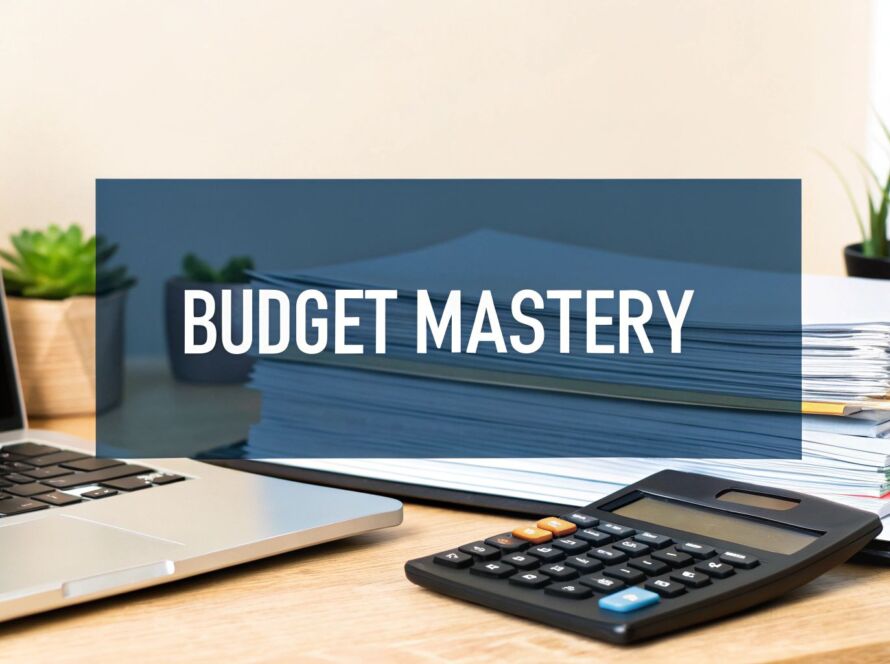Understanding Your Cost Structure (Without Getting Lost in Numbers)

To effectively reduce operational costs, you first need to understand exactly where your money is going. But this doesn't mean drowning in complex spreadsheets – it's about creating a clear, simple framework to analyze your spending. When you have this foundation, you can spot opportunities to cut costs and identify hidden expenses that may be eating into your profits.
Categorizing Expenses For Clarity
Think of expense categorization like creating a spending map for your business. Instead of putting everything under one big "overhead" bucket, break costs into specific groups like office supplies, utilities, and marketing. This detailed view makes it much easier to spot areas where you might be overspending. For instance, you might notice that office supply costs have crept up over time, or that certain utility bills are unusually high. This focused approach helps you make smart decisions about where to trim costs while protecting essential operations.
Unveiling Hidden Costs
Some of the biggest savings opportunities often hide in plain sight. These sneaky costs can include inefficient processes that waste time, outdated systems that slow everyone down, or resources you're paying for but barely using. A company might discover they're still paying monthly fees for software nobody uses anymore, or that poor packaging choices are driving up shipping costs unnecessarily. By taking time to examine every aspect of your operations with fresh eyes, you can uncover significant savings that were previously invisible.
Practical Frameworks For Analysis
Several proven methods can help you systematically review your expenses. Activity-Based Costing (ABC) links costs directly to specific activities rather than departments, showing you the true cost of each business activity. Another effective method is Zero-Based Budgeting (ZBB), where you start fresh each period and justify every expense from scratch. These structured approaches help reveal exactly where your money goes and highlight areas needing improvement. The results speak for themselves – in early 2023, US companies cut operating costs by 5.3% by using these kinds of systematic approaches.
Real-World Examples
Many businesses have found significant savings simply by getting clear on their spending patterns. One manufacturing company cut energy costs by 15% after installing basic energy monitoring – they could finally see exactly where power was being wasted and fix those issues. Another success story comes from a retail business that simplified its inventory system, cutting storage costs by 10% while keeping products consistently in stock. These examples show how understanding your costs leads naturally to smart improvements. When you have solid data about your spending, you can make confident decisions that strengthen your bottom line.
Smart Inventory Management That Makes a Difference

Getting inventory management right is essential for keeping your business costs down and your customers happy. When done well, smart inventory practices help companies save money while delivering better service. Many businesses are finding success by taking a fresh look at how they manage their stock – moving beyond basic counting to build systems that work smarter at every step.
Calculating Optimal Stock Levels
Finding the sweet spot with inventory levels takes careful planning. Keep too much on hand and you're wasting money on storage and tied-up capital. Keep too little and you risk running out when customers need products. The reorder point formula helps solve this challenge by calculating exactly when to replenish stock. The formula is simple: multiply your average daily sales by delivery lead time, then add safety stock. For example, if you sell 100 units weekly with a two-week lead time and want 20 units of safety stock, you'd reorder at 320 units (200 + 20). This gives you enough stock to cover demand plus a buffer for the unexpected.
Forecasting Demand Accurately
Good demand forecasting is key to getting inventory levels right and keeping costs in check. When you can predict what customers will want, you avoid costly rush orders and wasted stock. While advanced forecasting models exist, many businesses do well with simpler methods using sales history, market patterns, and input from their sales teams. For example, by tracking seasonal trends, you can plan ahead for busy periods instead of scrambling to keep up with demand spikes.
Choosing the Right Inventory Software
Good inventory software can make a huge difference, but picking the wrong system might create more problems than it solves. Focus on finding software that fits your specific needs rather than getting distracted by fancy features you won't use. Look for core capabilities like real-time tracking, automated reordering, and easy integration with your current tools. The reporting features are especially important – can the system show you key metrics about turnover rates and holding costs that help guide your decisions? With the right software match, you'll gain accuracy and efficiency that directly improves your bottom line.
Real-World Impact of Smart Inventory Management
The benefits of better inventory management show up clearly in real business results. Take the retail store that cut storage costs by 10% while actually improving product availability for customers. Or consider the manufacturer that switched to just-in-time inventory, dramatically reducing both storage needs and waste from expired materials. These examples show how focusing on inventory best practices creates positive changes throughout an operation. When you get inventory management right, you set your business up for meaningful cost savings and smoother operations overall.
Building Vendor Relationships That Save Money
Smart partnerships with vendors can dramatically reduce operational costs and create lasting value for your business. The right approach goes beyond simply haggling over prices – it's about developing mutually beneficial relationships that stand the test of time. Many companies have found that rethinking how they work with suppliers can save tens of thousands of dollars annually.
Identifying the Right Suppliers: Beyond the Bottom Line
Finding great vendors starts with looking past price alone. Quality, reliability, shared values, and total cost of ownership are all crucial factors to consider. For instance, a local supplier charging slightly more might save you money overall through faster deliveries that reduce inventory costs. Single-mindedly chasing the lowest bid often leads to hidden expenses from quality problems, delays, and unreliable service that erode any initial savings. A complete assessment of potential partners helps identify where the real value lies.
The Art of Negotiation: Creating Win-Win Scenarios
Success in vendor negotiations comes from finding common ground and mutual benefits, not aggressive tactics. For example, offering larger order volumes in exchange for better pricing can help both parties win. A small business might work out early payment discounts that improve cash flow while securing lower rates. Creative approaches like flexible payment terms or service bundles often reveal new ways to reduce costs. The goal is having both sides walk away satisfied and motivated to build a lasting partnership.
Competitive Bidding: Driving Down Costs While Preserving Relationships
Even with trusted vendors, periodic competitive bidding helps ensure market-appropriate pricing. The key is framing it constructively – as a way to assess market conditions and spot improvement opportunities rather than an adversarial process. Being transparent allows current suppliers to showcase their strengths while encouraging competitive offers. For instance, putting a service contract out to bid creates healthy competition that can spark innovation and better deals. Just as improvements in solar technology have steadily reduced costs over time, smart bidding practices can drive sustainable savings.
Framework for Vendor Relationship Management
A systematic approach to vendor relationships helps capture long-term value. This means establishing clear communication channels, performance metrics, and regular review processes. Scheduled check-ins, data-driven evaluations, and open dialogue build trust and allow both sides to address issues early. This ongoing engagement helps partnerships evolve with changing business needs while consistently delivering bottom-line benefits. A thoughtful vendor management framework ensures your supplier relationships remain aligned with cost reduction goals.
Technology Investments That Pay Off

Making smart choices about technology is just as important as managing inventory and vendor relationships when it comes to reducing costs. But success isn't about chasing every new tech trend – it's about making focused investments that deliver real results for your specific business needs. Let's explore how to make technology work for your bottom line.
Evaluating Technology's True ROI
Too often, companies get caught up in flashy features without considering the real impact on efficiency and costs. For instance, a business might spend heavily on a complex Customer Relationship Management (CRM) system loaded with capabilities they never use, only to see their IT expenses grow without any boost in sales. The key is to start with your specific goals and challenges, then choose solutions that directly address those needs. By taking this focused approach, you can ensure your tech spending truly helps reduce operational costs.
Automation: A Powerful Tool, But Proceed With Caution
While automation can dramatically cut costs by handling repetitive tasks and reducing errors, it's essential to be strategic about what you automate. Simply automating a flawed process will only make those problems happen faster. The best approach is to first identify tasks that are truly suited for automation – repetitive, rule-based activities where human error is common. Then select tools that work smoothly with your current systems. This methodical strategy helps ensure automation actually delivers the cost savings you're looking for.
Frameworks For Assessing Technology Investments
Just like other business decisions, technology investments need a clear structure for evaluation. This means setting specific objectives, thoroughly comparing potential solutions, analyzing costs versus benefits, and tracking results. For example, if you want to reduce customer support expenses, you might evaluate chatbot solutions based on concrete metrics like resolution times and staffing needs. This data-driven method helps ensure your technology spending aligns with your cost-reduction goals, especially for major infrastructure investments that can impact expenses for years to come.
Real-World Successes and Failures
Looking at real examples provides valuable perspective on technology investments. Consider one manufacturer that significantly lowered warehouse costs by implementing automated guided vehicles for materials handling. This change improved layout efficiency, inventory accuracy, and labor costs. On the flip side, another company invested in an overly complex Enterprise Resource Planning (ERP) system that ended up increasing training costs and frustrating users, ultimately raising their operational expenses. These contrasting cases show why careful planning and realistic expectations are crucial for technology investments that truly reduce costs over time.
Tracking Success Without Getting Buried in Data

Once you've put your cost-cutting plans into action, measuring their impact is essential. But here's the key – you need a simple way to track progress without creating endless reports that steal your time and energy. Smart companies know how to measure what really matters. Let's explore how to use data wisely to drive real improvements, not just create impressive-looking spreadsheets.
Key Performance Indicators (KPIs) That Matter
The right metrics make all the difference. Your KPIs should directly connect to areas where you expect to reduce costs. For instance, if you focused on inventory improvements, watch metrics like inventory turnover and storage costs. If you negotiated better vendor deals, keep an eye on your cost of goods sold. By zeroing in on just a few meaningful numbers, you'll get a clear view of your progress without drowning in data. Much like understanding your initial cost structure was vital, picking the right KPIs will show you exactly how well your changes are working.
Building a Tracking System That Works
You don't need a complex system to track effectively. Start by identifying where your key data lives – maybe it's in your accounting software, inventory system, or basic spreadsheets. Set up a consistent schedule, whether weekly, monthly, or quarterly, to check your progress. Make technology work for you – set up automatic reports from your systems to track important expenses. This removes manual data entry and frees you to focus on analysis and action. The goal is to make tracking helpful, not burdensome.
Turning Data Into Actionable Insights
Getting the data is just the first step – the real value comes from understanding what it means and taking action. Your tracking should clearly show if your cost-reduction strategies are delivering results. If the numbers aren't moving in the right direction, what needs to change? Think of your reports as guides for ongoing improvement. For example, if inventory isn't turning over faster despite your efforts, you might need to look at how you forecast demand or make purchasing decisions. By addressing root causes rather than symptoms, you can make lasting positive changes to your operations.
Avoiding Common Measurement Pitfalls
Many companies fall into the trap of tracking too many metrics, which makes it hard to see what's truly important. Another common mistake is forgetting to consider outside factors that affect your results. For example, if energy prices spike, you need to factor that in when evaluating your utility cost reduction efforts. We saw this play out in early 2023 when many US companies reduced operational costs by 5.3%, partly due to slower economic conditions. By understanding these factors, you can build an accurate picture of your real progress. This clear-eyed approach helps you make smart decisions based on reliable data and continuously improve your operational efficiency.
Creating Lasting Change in Your Organization
Reducing operational costs takes more than quick fixes – it requires embedding efficiency into your company's culture. The key is moving beyond simple cost-cutting to build sustainable practices that keep your organization lean while maintaining team spirit and growth potential. Let's explore practical ways to make cost-consciousness a natural part of how your company operates.
Engaging Employees in the Process
The most effective changes happen when everyone contributes their insights. Your frontline staff often see opportunities for improvement that management might miss – like ways to reduce material waste or streamline daily workflows. By being open about why cost reductions matter and actively seeking input, you'll gain better ideas and stronger commitment to making changes work. For instance, one manufacturing company saved over $100,000 annually after production workers suggested simple process tweaks they'd noticed were causing waste.
Maintaining Momentum Beyond Initial Wins
Early cost-saving victories create excitement, but keeping that energy going takes consistent effort. Regular check-ins to review progress, celebrate wins (big and small), and recognize individual contributions help sustain engagement. These touchpoints also reveal where plans need adjustment or new opportunities exist. Just like how Toyota made small, continuous improvements a cornerstone of their success, steady refinement leads to significant long-term savings.
Building Systems That Support Long-Term Success
Making cost-efficiency stick requires creating supporting structures and processes. This could mean setting up approval workflows in Asana to manage expenses, documenting best practices, or implementing time-saving automation. When cost-consciousness becomes "how we do things here" rather than a special initiative, it naturally shapes daily decisions and actions across the organization.
Balancing Cost Consciousness With Growth
Smart cost management enables growth rather than restricting it. Focus your resources on what creates the most value while trimming unnecessary expenses. For example, you might reduce office space costs to invest more in employee training or customer experience improvements. US companies averaged 5.3% operational cost reductions in early 2023, but the most successful ones did this strategically – cutting waste while protecting core capabilities.
Addressing Resistance and Maintaining Motivation
Change often faces pushback, even when it makes good business sense. The key is acknowledging concerns openly while showing how changes benefit everyone. Provide tools and training to help your team adapt, and consider incentives that reward cost-saving innovations. Clear communication about the "why" behind changes and visible support during the transition period help maintain trust and motivation.
Ready to build a more efficient organization that's positioned for sustainable growth? MarkBox Studios helps founders and business owners develop practical solutions that reduce costs while driving success. From strategic planning to hands-on implementation support, we provide the expertise you need to create lasting positive change. Contact us today to explore how we can help optimize your operations.



